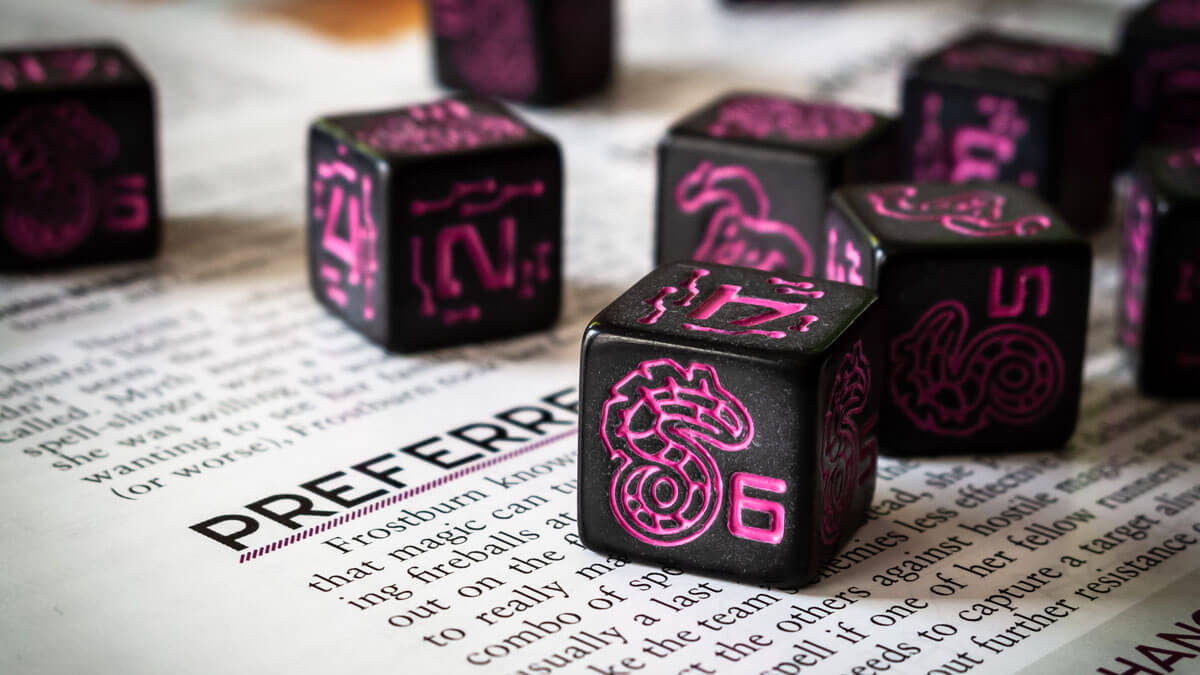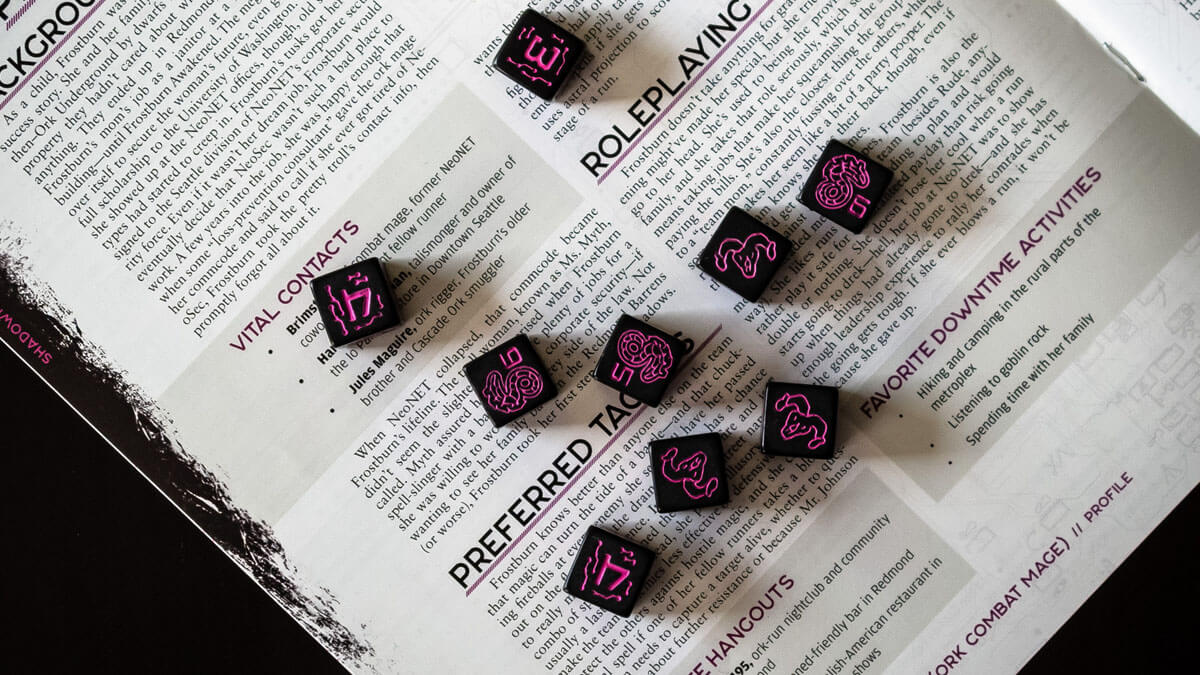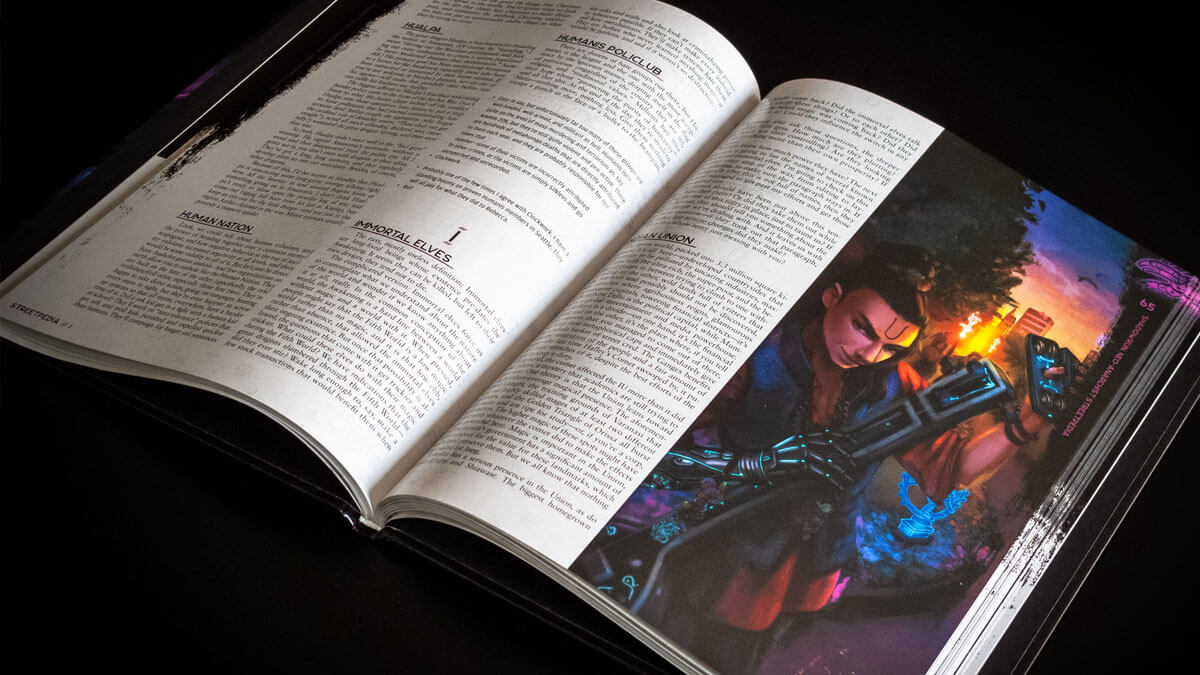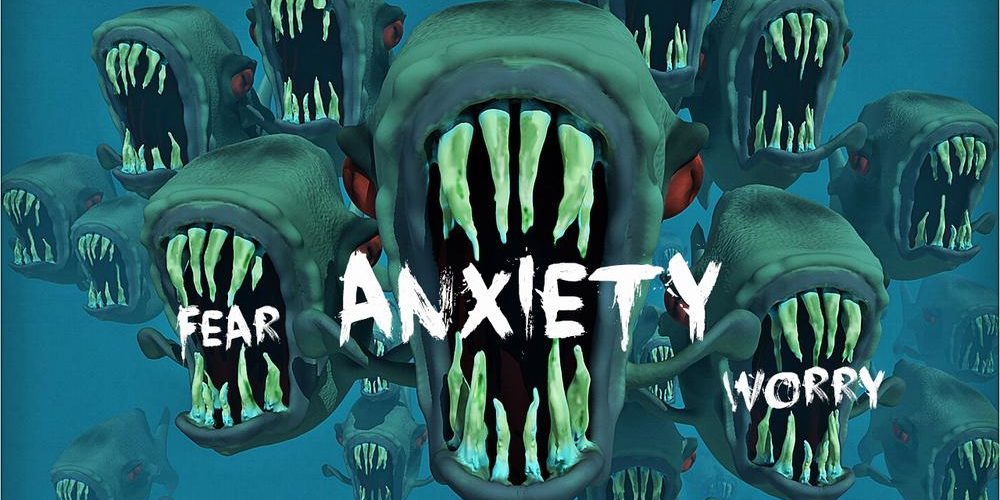As previously announced, Catalyst Game Labs dropped a surprise last month by announcing the sixth edition of their Shadowrun role-playing tabletop game and a release schedule of new books and products for its 30th anniversary. As someone who has played Shadowrun off and on since the 90s, typing “30th” makes me feel quite old.
Catalyst also kindly sent me copies of the first Sixth World products hot off the press: the Shadowrun Sixth World Beginner Box along with No Future and The Neo-Anarchist Streetpedia books. The Beginner Box previewed this past week at Origins Game Fair, with a retail release in July. Let’s take a look!

What is Shadowrun?
For the uninitiated, Shadowrun is a technicolor mix of classic cyberpunk and urban fantasy. You will find cyber-enhanced dwarf mercenaries with machine guns, elf mages slinging combat spells while riding motorcycles, elite hackers in the ubiquitous computer-connected Matrix, and even dragons holding down C-suite roles at tyrannical mega-corporations. Shadowrun seems to owe as much to the sword and sorcery genre as to William Gibson, Terri Windling, and classic heist films like The Italian Job.
In the game, player characters are an off-the-grid team of mercenaries, or “shadowrunners” for hire, each with unique magical, technological, or tactical talents. These talents are valued by those who need certain things done but don’t want to get their hands dirty. Shadowrunners’ lives are about team-sport survival; getting the job, doing the job (a “shadowrun”), trying not to get killed on the job, and getting paid for the job while living in a world that sees them both as fringe denizens and expendable resources.
A big reason Shadowrun interested me years ago was that the Pacific Northwest serves as a default setting; Seattle is an intrigue-filled cosmopolitan sprawl, and my hometown of Portland is the capital of a xenophobic elven nation (which makes a lot of sense, actually). There hasn’t been lack of in-game information on innumerable other domestic and international locales; there’s even a splatbook for Butte, Montana of all places. This world is as earnest as it is big and weirdly eccentric.

Components of Shadowrun Sixth World Beginner Box
- Welcome sheet
- 4-page overview of the Sixth World Setting
- 24 page Quick Start Rules book
- 24 page Battle Royale Adventure book
- 4 8-page character dossiers
- A double-sided map poster
- A deck of 54 quick-reference tool cards for items, weapons, spells, and stats on non-player characters (NPCs) used in the Battle Royale adventure
- 12 custom six-sided (d6) dice
Opening it up, I was greeted by a glossy welcome sheet giving a handy overview of the contents and instructions on where to begin.
Next in the box: An Instant Guide To The Sixth World is exactly as advertised, condensing over 80 in-universe years of a rather insane world history into four pages. I do not envy whoever assembled this material. It’s a LOT of content to summarize, given that Shadowrun’s story has been built upon by many authors over the past 30 years, but it is well written. The term “sixth world” has a double meaning here, referring to both the new sixth edition of the Shadowrun RPG ruleset and the in-universe narrative of a magical awakening which took Earth out of a mundane “fifth world” that has existed for much of (meta)human history.

Continuing on, I found four character dossiers. Each 8-page dossier contains an annotated character sheet, character history, tips on role-playing the character, and play tables specific for that character. A cool surprise was the included sample run. One column told a story in a narrative format; the next column framed all the character’s actions in the story using game terms, explaining what was rolled, what tests were used, and so on. This was really helpful in understanding the mechanisms of the game. Overall, the dossiers are a brilliant idea. The four characters represented are a diverse selection of Shadowrun archetypes: an ork combat mage, a troll street samurai, an elf face (the PR guy), and a dwarf decker (computer hacker).

The quick start rulebook is, naturally, a condensed version of the full core rulebook coming in August. Since is an introductory product, there are no rules for creating characters, and you may note that some things listed on the character sheet are not used for simplicity. I found the quick start rules fairly comprehensive while playing, and the tables in the back were handy.
I found the Battle Royale adventure under the rulebook; I’ll talk more on that below. Also included is a glossy fold-out map of Seattle with location call-outs on one side, and building maps specific to the adventure on the other.

The included d6s are 16mm engraved purple-on black dice with alternate designs for the success values (5 & 6) and glitch (1). Shadowrun can use a lot of dice in a single roll, so you’ll have to double-hand these. I recommend getting some 12mm dice (Chessex’s 12mm d6 blocks are great), even though they seem to enjoy the floor more than the table.
I like using spell cards in D&D, so seeing a deck of cards in the box was happy-making for me. The deck has stats for all the guns, vehicles, spells, and other gear used in the adventure. The NPC cards were particularly handy while running Battle Royale.
Gameplay of Shadowrun Sixth World Beginner Box
I’m not going to give a complete rules breakdown or do a heavy comparison to previous editions, but I’ll touch on the basics and talk about some new aspects from Sixth World.
For the quick start rules, each character has a range of physical and mental attributes, along with the special attributes of magic and essence for awakened magical characters. Most of these attributes link to the skills a character possesses. For example, the Body attribute is linked to the Athletics skill, and the Agility attribute is linked up with the Firearms skill. The ratings on each indicate how many dice you roll when testing that skill; combining the values of attribute and skill to make a dice pool. A simple test means rolling a dice pool to achieve hits to match or beat a threshold number set by the GM to see if your character succeeds. A 5 or 6 on a die counts as a hit. A 1 on a die isn’t a bad thing, but if more than half of your roll comes up as 1s, that is a “glitch” and bad things will happen.
Simple tests, dice pools, and attribute/skill links are not new with the sixth edition. However, what is a significant departure is the new Edge point mechanic tied in with Attack Ratings and Defense Ratings.
In previous editions, Shadowrun’s combat rules have been notoriously complex, at least in my experience. The seemingly simple task of firing a weapon requires a whole bucket of modifiers to consider: visibility, range, ammo type, armor, tech add-ons, and even recoil. Sixth World’s Edge and Attack Rating/Defense Rating mechanisms abstracts much of this into a simpler structure.

The Attack Rating is an abstract number that takes into account the accuracy, quality, range, and any modifications of the weapon you are firing. The Defense Rating is determined by the armor and Body attribute of the target you are shooting at. These values are compared, along with environmental modifiers. The winner gets Edge points to spend! Edge is also an abstraction; here it represents the advantage a character could have in a situation, whether by luck, skill, or the fates.
There are specific rules on where and when Edge can be spent, but it gives you boosts and advantages including rerolling a die (costs 1 Edge) or healing a small amount of damage (costs 4 Edge), for example. There’s a whole bunch of stuff you can do with Edge, including spending 2 Edge to give an ally an Edge. Edge can also be awarded and spent in role-playing social situations and tests other than combat.
Edge can be tracked on a character sheet, but that’s boring. For our game, we used specialized Edge tokens I picked up at the supermarket (a.k.a. Starburst candy).
There are also pages dedicated to Matrix hacking and magical abilities; again, very condensed rules, but enough to get you going on spellcasting and how to use (and abuse) the Matrix. Curiously, there are also rules for a rigger: a character that specializes in operating vehicles and drones via a cybernetic connection. I learned a rigger character dossier will be available for download on Shadowrun’s Sixth World website soon.
Playing the Battle Royale adventure (minor spoilers)
My players were familiar with Shadowrun in varying degrees, so they didn’t require much introduction. After giving them time to look and choose a character, I gave an overview of tests and Edge, and then we were off to the races. I’m not a fan of rules dumps. My method of teaching RPGs (or any game for that matter) is to provide enough rules to get the game going, then fill in the blanks as we play. That method seems to work the best with Shadowrun; just give enough info to keep moving. Back to the book…
Published Shadowrun adventures have followed a consistent structure over the years, and Battle Royale continues that tradition. The adventure is divided into scenes with the same subheads: one gives general outline of the narrative, another gives descriptive text to read out loud to players, next is a “behind the scenes” section covering all aspects of the scene and NPC motivations, and then a “debugging” section to help if characters go completely off track.

Without giving out too much detail, Battle Royale expands on the classic “food fight” convenience store scenario that’s been used in previous Shadowrun intro products for a long time. It’s not a bad idea; it allows everyone to jump into role-playing and the combat rules without a ton of setup, using a “wrong place at the wrong time” situation. It also hammers home the world of Shadowrun; you could find danger (or opportunity) anytime without even looking for it. However, the adventure is not a typical shadowrun where the team accepts the job, devises the plan that “just can’t fail”, and then executes it, usually going pear-shaped in some aspect (“You’re only supposed to blow the fraggin’ doors off!”). The challenge in a quick wrong place story is finding motivation for characters to care about what is happening enough to get involved; just getting the heck out of dodge is a legit move, though anti-climatic. In some respects, I wish the example run in the character dossiers had been used as the intro adventure to give new players a good taste of a typical run, as well as the rules. My players approached the main conflict of Battle Royale in a way that wasn’t specifically outlined in the book, but off-the-cuff thinking is a GM’s life in any game and part of the fun, at least for me.
The map and Battle Royale’s informational section about the Seattle metroplex and notable locations is a curious addition. It is fun info but doesn’t play into the proceedings as everything happens in one location. The buildings on the back of the map are re-used art, including the same black-and-white Stuffer Shack illustration that’s been used for past editions.
Battle Royale took us about 4 hours to complete, including 15-20 minutes of exploring the character dossiers. It felt like a good length for a single session. The story is perfectly fine and we all had a lot of fun playing, but I think the adventure could have had more “training wheels” for new GMs. For example, giving rules reminders in the text and/or referencing pages from the quick start rulebook when applicable. I got the impression that the booklets were created tangentially from each other as I was referencing information.

As I said, the character dossiers are awesome, but it would have been nice to have separate preprinted character sheets (on uncoated paper) as well. The dossiers have the character sheets in a center spread, so it can be a little awkward to flip through when you are looking up a table and want to reference back to the character sheet. I photocopied the character sheets to make it easier for my players to use.

Sometimes, it’s not so clear on where to find certain information. For example, on the tool cards, the Attack Rating on a weapon is listed on the weapon’s range table. The table is labeled as “Range” with no indication that the number is the Attack Rating. It would have been easier if there were more consistent nomenclature across the board, but it’s not a deal breaker by any means.
Who is Shadowrun Sixth World Beginner Box for?
I’ve always considered Shadowrun a “next level” tabletop RPG; one for experienced players due to the complexity of the rules and a wide variety of options for characters. However, with the abstracted mechanics introduced in Sixth World, I can recommend the Beginner Box to anyone who is interested in exploring the world of Shadowrun and/or new GM comfortable with thinking on the fly.
Another thing to note: Shadowrun is generally not a family-friendly place. It’s full of violence, horror, racism, corporate greed, lawlessness (or subjective definitions of “law”), and technology running amok. Given the themes, I recommend Shadowrun for older teens and up. Of course, content can be adjusted, but some of the most interesting Shadowrun adventures deal with moral ambiguities and the guiding aphorism “everything has a price.” In the Sixth World, even doing the right thing should cost players something.
Overall, I found the Beginner Box a great value and a fun taste of what awaits current Shadowrun fans (and future fans) in August.

A Quick Preview of the Sixth World Books
These new sourcebooks were in the 5th edition pipeline, but updated to SIxth World.
In all editions, Shadowrun sourcebooks have more or less maintained a consistent narrative style. In-universe information is presented as if it were aggregated content stored on an underground computer server and is frequently annotated with peanut gallery commentary by notable shadowrunners. These books don’t deviate from that entertaining formula.

The Neo-Anarchist Streetpedia
The Streetpedia covers just about every notable person, shadowrunner, organization, dragon, event, corporation, and locale that shaped the Shadowrun world over its 80 in-game years. What is Maria Mercurial up to these days? What was the Artifact Rush of the 2070s? It’s all in there. There is no additional rule content, but this is a treasure trove for GMs and players who love the lore and/or need quick background info for homebrew adventures built on published material.

No Future
No Future is a comprehensive sourcebook on entertainment, media, music, and pop culture; containing related rules and gear for player characters. This was released electronically for 5th edition earlier this year but has been updated for Sixth World. So why buy the book when you have the updated PDF already? Well, for one, the book is stunning; this is one of the best looking Shadowrun books I’ve seen, arriving in an augmented reality-themed plastic slipcase. I’ve had mixed feelings on Shadowrun art over the years, but most everything I’ve seen with Sixth World so far has shown a step up in art direction. No Future is a nice addition to the Shadowrun bookshelf.
The Shadowrun Sixth World Beginner Box was released this past weekend at Origins Game Fair and will be available from retailers shortly after. The Neo-Anarchist Streetpedia is releasing later this month, and No Future releases in July.
Click here to see all our tabletop game reviews.
![]() To subscribe to GeekDad’s tabletop gaming coverage, please copy this link and add it to your RSS reader.
To subscribe to GeekDad’s tabletop gaming coverage, please copy this link and add it to your RSS reader.
Disclosure: GeekDad received a copy of this game and books for review purposes.





